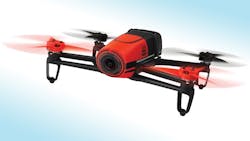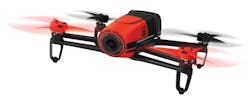The Federal Aviation Administration (FAA) has held up the commercial use of drones because there were no rules in place. Its recent change may be approved by now, but it will open up at least some opportunities for drone pilots to take to the sky. Until now, drone use required special permission from the FAA. Of course, these limitations have not stopped use by hobbyists and developers, but commercial users got smacked down.
At this point, hobbyists and non-commercial users can operate drones like Parrot’s Bebop Drone (see the figure) as long as they stay below 400 feet. Users must notify air-traffic control when using a drone within 5 miles of an airport. Drones must be within visual line-of-sight (VLOS). These are essentially the rules for RC planes that have been in use for decades.
The proposed drone rules are restrictive, but they should make commercial drone usage more common. Drones will have to be piloted by someone who is at least 17 years of age and has passed an FAA test and been vetted by the Transportation Security Administration (TSA). There had been discussion of requiring a pilot’s license, but that was deemed too restrictive.
The maximum altitude is 500 feet and the max weight is 25 kg. Operation has to be during daylight hours and VLOS. Speeds must be under 100 miles/hour. The drone can not be flown over people not related to the operator’s mission (so it could be used by a film crew). A microUAS (under 2 kg) option has been proposed that would loosen this restriction for certain certified operators.
The new rules will make it easier for vendors to deliver equipment that meets these requirements. It will finally allow more general use of drones for commercial purposes. Hopefully these rules can be amended in the future to be more flexible as more experience is gained and more sophisticated drones are made available.
Looking for parts? Go to SourceESB.About the Author
William Wong Blog
Senior Content Director
Bill's latest articles are listed on this author page, William G. Wong.
Bill Wong covers Digital, Embedded, Systems and Software topics at Electronic Design. He writes a number of columns, including Lab Bench and alt.embedded, plus Bill's Workbench hands-on column. Bill is a Georgia Tech alumni with a B.S in Electrical Engineering and a master's degree in computer science for Rutgers, The State University of New Jersey.
He has written a dozen books and was the first Director of PC Labs at PC Magazine. He has worked in the computer and publication industry for almost 40 years and has been with Electronic Design since 2000. He helps run the Mercer Science and Engineering Fair in Mercer County, NJ.
- Check out more articles by Bill Wong on Electronic Design
- Bill Wong on Facebook
- @AltEmbedded on Twitter

